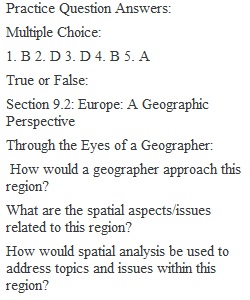


Q Section 9.2: Europe: A Geographic Perspective Through the Eyes of a Geographer: How would a geographer approach this region? What are the spatial aspects/issues related to this region? How would spatial analysis be used to address topics and issues within this region? What are the where and why questions? How can this region be studied and analyzed using the five themes of geography? How do most Americans perceive this region? Overview: For centuries Europe has enjoyed global prominence and influence. This position of power has been gained in part by Europe’s global relative location along with dominant values and beliefs. Where Europe is located provides maximum opportunity for contact with the rest of the world. The historical geography of Europe reveals the importance of location and use of waterways to build empires and gain wealth. By 1918, Europe powers had colonized 85% of the globe, giving Europe unparalleled global dominance and influence. In recent years, Europe has struggled with its overall identity and a variety of economic, political, cultural, and social issues. Although many generalizations can be made about this world region, the countries of Europe are characterized by great diversity and spatial variation within their human and physical landscapes. Critical Thinking/Discussion Questions: 1. Why has Europe been a major political, economic, and cultural global influence for centuries? What has Europe’s dominance meant for other countries? 2. How did Europe emerge as a world power? What role did the physical environment and colonialism play? What are some dominant beliefs and values from this world region? Have these components of culture diffused to other locations of the world though colonialism and other means? 3. What are the reasons for the high degree of spatial variation that exists in Europe, namely the regional physical, cultural, and economic differences? What about current issues and challenges that individual European countries face? Practice Questions (Write Correct Answer in Blank): Multiple Choice: 1. ___ What factor does NOT account for the rise of Europe as the center of world trade and industrialization: A) capitalism B) war C) science D) technology 2. ___ The Eastern Orthodox Christian Church is dominant in: A) Germany B) France C) England D) Greece 3. ___ This country possesses one of the major centers of international finance, and its banks enjoy an international reputation for security, discretion, and service: A) Germany B) Belgium C) Austria D) Switzerland 4. ___ The cultural and physical landscapes of Europe are highly: A) uniform B) diverse C) similar D) homogeneous 5. ___ The largest landmass in the world is: A) Eurasia B) North America C) South America D) Africa True or False: 1. ___ Europe’s global relative location is a key factor in this region’s world dominance. 2. ___ Because of its relatively small size, the European landscape is highly homogenous (lacking in diversity). 3. ___ A major reason for European colonization in Africa was a quest for raw materials to help fuel the industrial revolution in Europe. 4. ___ Access to the sea and other waterways was vital to European growth. 5. ___ The post-WW II conflict between the United States and Soviet Union can best be defined as a “Hot War.”
View Related Questions